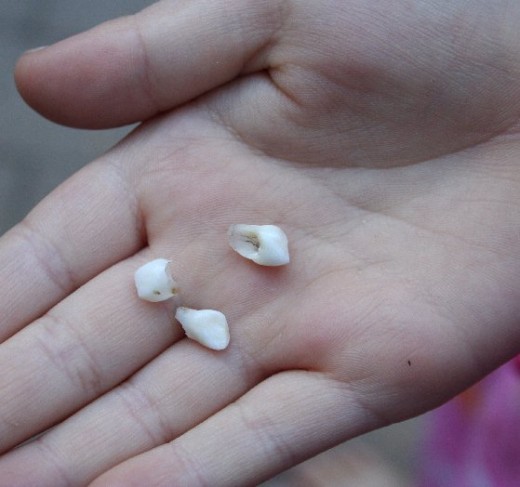What the Tooth Fairy Will Pay: A Leading Economic Indicator
Are we in the United States suffering the effects of a deflationary economy? Are we in the throes of rampant deflation, just like Japan? For that matter, is Japan really suffering from deflation? How do we define deflation? Is the absence of inflation good enough to make it deflation, or does the currency have to actually buy more than it used to? And more of what, exactly? Pork bellies, laptops, coffeemakers? How about eggs? What would constitute irrefutable proof that it's deflation? Is there any one leading economic indicator that would tell us?
Surely, there are experts who will give a definitive answer. I'm just way too preoccupied to look it up. But lots of people seem to be worried about deflation. I know, because occasionally I visit the Hubpages Forums.
I don't have time to think about this. I am very busy revising my play The Debt Collector. I have no time to worry about economic issues. So I let the whole thing slide.
The Process of Revision
So I'm going through the play, and in the play Mrs. Hauser, the landlady, is trying to collect $550.00 of back rent from the Lark family. I wonder about that sum. A rent house for a family like the Larks in my neck of the woods would run between $450.00 to $550.00 per month. Of course, I live in the rural Ozarks, and the Larks, well, the Larks lived in the Dallas-Ft. Worth Metroplex around 1985. So, even though rent here is comparable, maybe over there it's not that way, anymore.
Should I change the amount of back rent they owe? If so, which way? Up or down?
Our Chickens Lay Eggs and Cause Deflation



The Going Rate for Baby Teeth

The Price of Eggs
This revision process is driving me crazy. I like the play the way it is. I don't want to change a single word. But will current day audiences accept that it only costs a quarter to play a Planetbuster video game at the grocery store? Who would believe that?
For that matter, is $20.00 not a little low for a Planetbuster game that you can take home with you? My daughter tells me she needs $40.00 to buy a new game for her DSi. But it's not really comparable, is it? The technology has changed.
Bow sends me off to the refrigerator to prepare lunch. There's no room in there. Everything is full of eggs. Eggs everywhere, but no cartons to put them in. I haven't bought eggs in ages. Not since our hens started laying.
But the price of eggs has gone down recently. It's around a dollar a dozen. Is it because I -- and other people --- started raising chickens that the price of eggs went down?
Are eggs a leading economic indicator? Is this proof that there is deflation?
But why can't I buy more of the things I really want with my money? I don't want to buy eggs. It does me no good that the price of eggs has gone down. Is that what it takes to bring the price of things down? That you don't want them, anymore?
The Tooth Fairy
If we go by any one commodity, then we can't know for sure that when its price goes down, we are in a deflationary phase. It could be just a fluke, this thing with eggs. It could be well-off suburbanites who decided to raise chickens that brought the price of eggs down, rather than the bulk of the poor and unemployed who can no longer afford to buy groceries. It could be a trendy thing, like Marie Antoinette playing at country life.
So I go back to my script, and Sophie wants to raise twenty dollars to buy that Planetbuster game. She starts to list the money raising schemes available. She has a loose tooth, and when it comes out, it'll earn her a quarter from the tooth fairy.
A quarter! Just a quarter? Why, I happen to know for a fact that today's tooth fairy pays a dollar a tooth! I know, because I'm a mother, and it's my business to know these things. If we use the tooth fairy as an economic indicator, then today's dollar is worth a quarter of the dollar in 1985. That is serious inflation.
It means that all the little children who lost teeth in the 1980s and stashed their loot in their mattresses have had seventy-five cents out of every dollar stolen from them! Or if not that, it means that children who were paid for four teeth in 1985, and kept the money, can now only pay their own children for one tooth with that dollar.
I am so overcome by this realization, that I stop dead in my tracks.
The tooth fairy as a leading economic indicator
Do you have the same data as I do? Do your tooth fairy experiences jive with mine? If so, I propose that we stop paying attention to the price of other commodities and focus on the tooth fairy's going rate. Because children are given this money to spend as they will, then it doesn't matter what the price of eggs might be or the price of video games. This covers the entire economy and anything worth buying.
Has the tooth fairy's rate gone down since the recent economic decline? If it hasn't, then it's not deflation.
And with that mystery solved, I'll go back to revising my script. Should I change a quarter to a dollar in the updated version? What do you think?
(c) 2010 Aya Katz
Related Hubs and Links
- Notes from the Pens
- Our Chickens
When I told my mother that I was planning to get chickens, she tried to dissuade me. "But Aya, you don't even like chickens." It's true. She raised chickens when I was a teenager, and the way the chickens... - We All Share the Same World by Aya Katz and Daniel Carter
A new stage musical in progress called "The Debt Collector" shares the feature song from the work. By Aya Katz and Daniel Carter. - The Connection between Economy and Ecology
Many people believe that government bailouts of ailing businesses are necessary, because these businesses employ most people, and without the bailouts all would be jobless, homeless and might even go hungry.... - Support Your Local Musical Theatre
The first musical I ever saw was (pronounced Utz Li Gutz Li). I was five years old. I liked it so much that I asked to see it again. My parents bought the record, and they copied it... - Deflation - What is It and Why are We Worried About It?
August 24, 2010 The word deflation is being used with increasing frequency these days when the discussion involves the economy or markets. In addition, when the word deflation is used, there is an ominous... - How to Brew Coffee Using a Broken Coffee Maker
I don't mind spending money on appliances. I understand that if I want a coffee maker, I have to pay for one. If I want two coffee makers, I have to pay for two coffee makers. If I want three coffee makers,...









